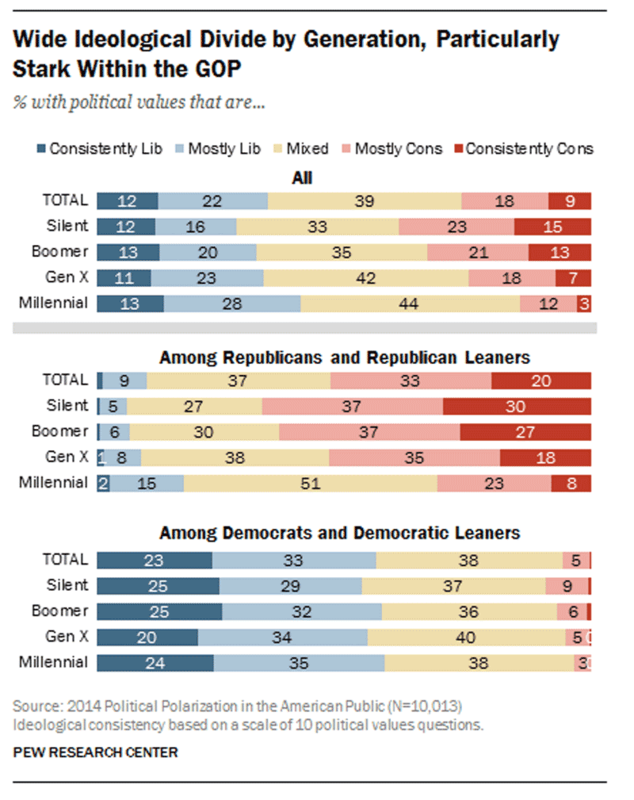As publishers move strategically to capture that large and lucrative demographic known as millennials, many will have an ideal reader in mind. That reader may be predominantly male or female, LGBT or minority, or have a preference for cultural fare over sports, but they’re definitely young, and they’re probably liberal.
So it’s interesting that a handful of publishers appear to be hunting a rarer breed, called “the conservative millennial.” Even though they are significantly outnumbered by millennials who lean to the left, some publishers see in them a business opportunity, a chance to carve out a niche in a landscape awash in content, heralding in a new generation of right-leaning digital natives.
The most notable new example is Bold, a news site launched this week that’s aimed at conservative female, LGBT, and minority readers–an audience that Carrie Sheffield, the site’s founder and editorial director, who also blogs for Forbes, describes as underserved and “untapped” in the current media environment.
“There is a need, and people will be hungry for a voice that is moderately conservative and respectful,” Sheffield told CNN. “That’s what we’re going for.” Unabashedly strategic, Sheffield describes the site as a cross between Young Turks and Morning Joe that sits, politically speaking, somewhere between The Wall Street Journal and Fox News.
Another recent, though less obvious, player to emerge in the digital, right-leaning news market may be Circa, the widely celebrated news app that died a sudden death and is now being resurrected by Sinclair Broadcast Group, Inc., a telecommunications company with a history of making politically motivated programming decisions. What made the first iteration of Circa so exciting was its technology, which was designed to deliver a “more pure definition” of news–one that “deconstructs facts from fluff,” analysis, and bias–in the form of cleverly packaged, easily personalized, user-generated content. Although Circa’s technology remains in tact, many are wondering how its new owners will deploy it, given the company’s past political missteps. When Rob Weisbord, the vice president and chief operating officer of Sinclair’s Digital Group, told The Wall Street Journal that “far-left” news sites like Vox and Vice had left an opening in the market, a robust Twitter critique ensued.
Sinclair’s not the one to do it, but there is an interesting critique to be done of the left-of-center nature of millennialish news sites.
— Joshua Benton (@jbenton) December 7, 2015
“Sinclair’s not the one to do it, but there is an interesting critique to be done of the left-of-center nature of millennialish news sites,” Nieman Lab’s Joshua Benton tweeted.
Responding to the The Wall Street Journal article, which stated that “the newly launched Circa would let readers make up their own minds about stories,” Jay Rosen tweeted: “… Yeah. This reads to me like code for a more conservative bent to stories and especially story selection.”
@mathewi Yeah. This reads to me like code for a more conservative bent to stories and especially story selection. pic.twitter.com/hl7C4WzNCu
— Jay Rosen (@jayrosen_nyu) December 7, 2015
There’s also the fact that a strategic partnership with Sinclair Affiliate Program will provide Circa with as much as 2,100 hours of video a week from 100-plus TV stations around the country. In others words, a juggernaut of mobile video content, which could have a conservative political tilt.
“Those videos served their market well, but we can liberate them and take them nationwide, make them national news and expose it to a wider audience,” says John Solomon, Circa’s new chief creative officer. “That strategic partnership with the Sinclair Affiliates plus the technology gives us a pretty nice runway to take off from.”
Seeking to soothe concerns and clarify Circa’s position, Solomon insists that what’s driving Circa isn’t a political agenda. It’s market opportunity.
“I haven’t seen or heard anything that says this is a conservative news site other than the predisposition of some reporters to assume that because Sinclair’s investment arm made an initial investment in this,” Solomon says, calling Sinclair Ventures “a completely separate entity.”
Asked to describe his vision for Circa, Solomon says, “There are a lot of sites in the millennial space, or new reader space, that have a center-left bent. I think most reporters would agree with that. So the opportunity isn’t to swing to the right. The focus groups I’ve been in with millennials over the years as the editor of a newspaper, everything I’ve heard is don’t lead us by the nose with an opinion. We don’t want a point of view. We just want the facts, and let us make up our own minds. So the potential for what we can do for the market is just to do fact-based, independent, raw, transparent journalism without all the screaming, yelling shrillness of the political left-right struggle.”
Wherever Circa lands on the political map, there is some precedent that carving out a right-of-center position may be good for business. Just two years after its launch in 2012, the Independent Journal Review, described by Digiday as “an ideological cross between Drudge Report and Upworthy,” had become the 45th most-trafficked site on the Web, surpassing The New York Times and Fox News, and prompting BuzzFeed to dub it the Right Wing’s version of Upworthy.
“It’s a formula derived from the tradition of old-school conservative email chains, which combine a taste for the conspiratorial with a general distrust for mainstream media,” Digiday reported. Cox Media Group’s Rare.us, another “destination for conservative news, blogs, opinions, and original content,” draws 19.8 million US uniques every month, according to Quantcast.com. As of July, Independent Journal Review’s traffic of 20 million monthly uniques was reportedly flat as compared with last year, but it was also moving away from just being a viral publisher into breaking real news.
What’s driving this market is likely a combination of factors, including a heated political season, political advertising dollars, and shifting voting patterns. Republicans have struggled to connect with millennials, but a recent study by the Harvard Institute of Politics found indications that younger millennials, the ones who grew up in a post 9/11 world in the grip of economic recession, may not be as liberal as older millennials. If that’s the case, some publishers may be looking to capture those eyeballs now and plant their flag in the market early, while there’s still plenty of room to grow.
Damaris Colhoun is CJR’s digital correspondent covering the media business. A reporter at large in New York, Colhoun has also written for The Believer, The New York Times, The Guardian, and Atlas Obscura. Find her on Twitter @damarisdeere.


